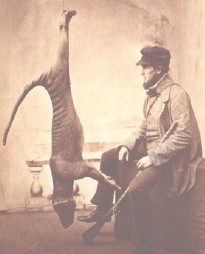(单词翻译:单击)
that if you wished to find all the dodos in a vicinity you had only to catch one and set it to squawking,
要是你想找到附近的所有渡渡鸟,你只要抓住其中的一只,并且让它叫个不停,
and all the others would waddle along to see what was up.
所有其他的同类就会摇摇摆摆地走过来,看看究竟发生了什么事。
The indignities to the poor dodo didn't end quite there.
对于可怜的渡渡鸟的摧残并没有到此为止。
In 1755, some seventy years after the last dodo's death, the director of the Ashmolean Museum in Oxford
在最后一只渡渡鸟死后大约70年,也就是1755年,牛津阿什莫利恩博物馆的馆长
decided that the institution's stuffed dodo was becoming unpleasantly musty and ordered it tossed on a bonfire.
发现该馆的渡渡鸟标本发了霉,就命令手下的人将它扔到火里烧掉。
This was a surprising decision as it was by this time the only dodo in existence, stuffed or otherwise.
这真是一个令人吃惊的决定,因为那可是世上仅有的——不论是标本还是活物一只渡渡鸟了。
A passing employee, aghast, tried to rescue the bird but could save only its head and part of one limb.
一个碰巧路过的员工被他的这一举动吓坏了,试图将那只鸟从火中救出来,可是最终只救出了它的头和一部分腿。
As a result of this and other departures from common sense, we are not now entirely sure what a living dodo was like.
这样做的结果,以及由于别的背离常识的举动,我们现在几乎不能完全确定一只活着的渡渡鸟长什么样。
We possess much less information than most people suppose
我们所拥有的信息比大多数人想像的要少得多
a handful of crude descriptions by "unscientific voyagers, three or four oil paintings, and a few scattered osseous fragments," in the somewhat aggrieved words of the nineteenth-century naturalist H. E. Strickland.
正如19世纪博物学家H.R.斯特里克兰不无愠怒地描绘的那样,“几个不值科学的海员”写的几段简单的描述、“三四幅油画,以及几块散落的骨头碎片”,就是有关渡渡鸟的全部资料。

As Strickland wistfully observed, we have more physical evidence of some ancient sea monsters and lumbering saurapods
依照斯特里克兰的说法,我们所掌握的有关一些古代海兽和庞大的蜥脚类动物的资料比渡渡鸟还要具体得多。
than we do of a bird that lived into modern times and required nothing of us to survive except our absence.
而后者一直生存到现代,它们对我们别无所求,只要求我们远离它们,以便活下去。
So what is known of the dodo is this: it lived on Mauritius, was plump but not tasty, and was the biggest-ever member of the pigeon family,
综合起来,我们所知道的有关渡渡鸟的情况足这样的:它生活于毛里求斯,体态丰满,但味道并不鲜美,是鸠鸽家族中个儿最大的成员。
though by quite what margin is unknown as its weight was never accurately recorded.
不过,它的个儿究竟有多大,我们不知道,因为它的体重从未有过精确的记录。
Extrapolations from Strickland's "osseous fragments" and the Ashmolean's modest remains show that it was a little over two and a half feet tall
根据斯特里克兰所提到的“骨头碎片”以及阿什莫利恩的残缺标本,我们可以大致推测出它的身高约80厘米,
and about the same distance from beak tip to backside.
从嘴尖到臀部的距离几乎相等。


